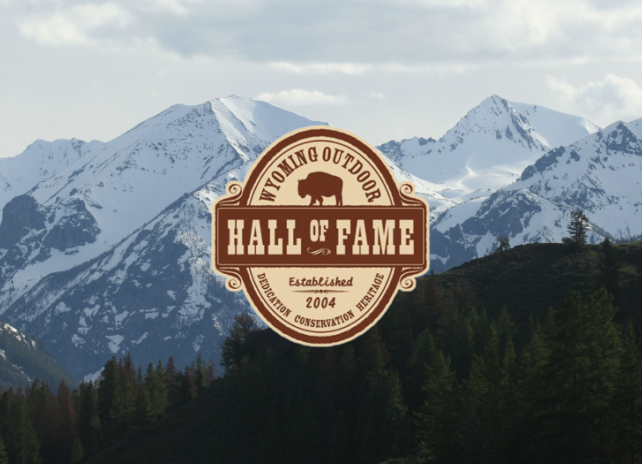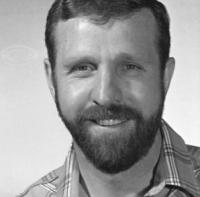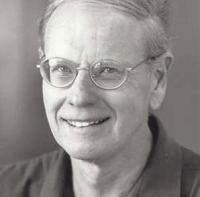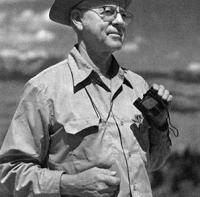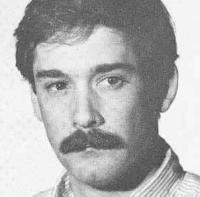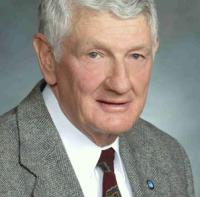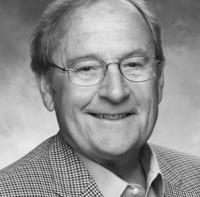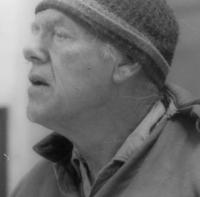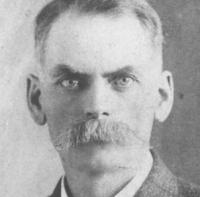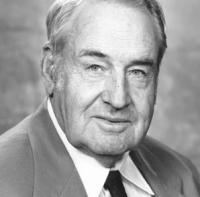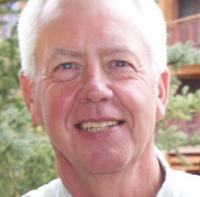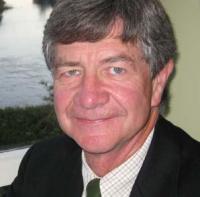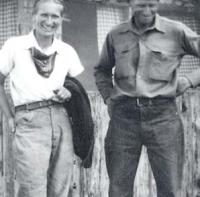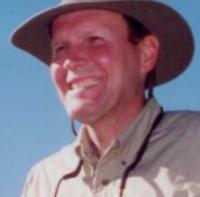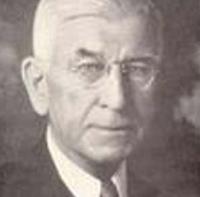Joe Back was born April 12, 1899, in Montpelier, Ohio. His father was a country doctor who visited his patients by horse and buggy. A lover of horses, he maintained a breeding stable when not practicing medicine. Through him, Joe developed knowledge of horses at the earliest age, handling the buggy as his father made his rounds.
When Joe was only 9 years old his father died of a sudden heart attack. His mother relocated to California where she soon remarried. Joe could not get along with his stepfather who was quite a drinker; so when he got in trouble at school for drawing sketches of his 8th grade teacher, he decided that was enough of that whole situation and took off on his own.
Joe’s mother had a cousin who managed the Fiddleback Ranch north of Douglas, so Joe headed there and was put to work as a chore-boy for board and room. Having learned to handle horses from his father, he was soon promoted to full ranch hand status with wages of $45 a month.
With the onset of World War I, Joe entered the Navy. Proficient with firearms, he was assigned to be a machine gun instructor and the closest thing to an ocean he ever saw was Lake Michigan. Discharged in 1919, Joe returned to Douglas and began cowboying on the 55 Ranch for ranch foreman Wheeler Eskew. Wheeler was a top hand and Joe considered him “one of the finest men I ever got to know.”
Joe had filed on a homestead 42 miles north of Douglas and had begun the improvements necessary to obtain full ownership when he heard about a big horse roundup. Hiring on with 6 or 8 other cowboys, they eventually caught several hundred stray horses, which were to be purchased by the Diamond G Guest ranch above Dubois. They then obtained a chuck wagon and rope corral and herded the horses from Douglas to Brooks Lake and the Diamond G, a distance of approximately 270 miles. The trip took 2 weeks and was filled with adventure.
The Diamond G wanted Joe to stay on as a wrangler and guide, so he leased the grass on his homestead and remained in the mountains. He began guiding summer pack trips in the Teton Wilderness, including trips as far as Lewis Lake in Yellowstone National Park. In the fall, he would guide elk, deer, and bighorn sheep hunters.
Joe Back had always liked to draw and sketch and the Brooks Lake country was full of subject material. He began making sketches of horses, mountains, and cowboys and gave them away to ranch guests. One summer-long guest was Louis Agassiz Fuertes, a staff artist with National Geographic. When he saw Joe’s sketches, he encouraged him to attend the Art Institute of Chicago.
Initially rejected because he had only completed the 8th grade, Joe figured that was the end of that idea. But when Fuertes found out about it, he gathered up Joe’s sketches and sent them to the Institute with a strongly worded letter; Joe was accepted. He quickly sold his homestead and headed east. It was at the Art Institute of Chicago that Joe would meet his future wife and lifelong partner.
Mary Waters Cooper was born on Dec. 3, 1906 in Minneapolis, Minnesota. While still an infant, her father moved the family to Vermont. Even as a young child, Mary’s interests in nature and art were evident. Her notebooks would be festooned with drawings, often of plants or animals. Her father was a member of the Green Mountain Club, which established hiking trails reaching to Canada, so Mary spent weekends hiking the hills and clearing trails. Early pictures show Mary with various animals, including several pet snakes.
Graduating from high school at the age of 16, Mary was admitted to Berea College in Kentucky. A small, prestigious school, Berea charged no tuition but required students to hold jobs at the college. When Mary arrived, she brought one of her pet snakes which caused quite a commotion and was eventually placed in the biology lab.
While Mary was at college, her family relocated to Chicago. Joining them there following graduation, she began taking classes at the Art Institute of Chicago. Classes in animal anatomy were held at the Field Museum of Natural History, and one day while Mary was sketching animals, someone walked up behind her and remarked, “That’s a helluva good bear!” It was Joe Back.
Joe courted Mary during 1931 and 1932, and they finally married in February of 1933, during the great depression. Jobs were scarce, but Joe was hired as a foreman by the National Park Service for $175 a month, and Mary was appointed to run a trailside wildlife museum for $100 per month. They lived on Joe’s salary and saved Mary’s earnings with a plan to move to Wyoming.
In the spring of 1935, Joe and Mary bought a 1927 Buick to make the trip west. They sewed a canvas tent which could be affixed to the side of the car and camped their way through the country, arriving at Dubois, Wyoming, Joe’s old stomping ground.
Moving to the high country, Mary and Joe purchased the abandoned and dilapidated Lava Creek Ranch. Working nearly round the clock, they rendered the ranch cabins ready for winter. And that first winter was a tough one with deep snow and cold temperatures. Joe would take 2 days to snowshoe the 22 miles to Dubois for the mail and a few groceries. But they both decided to stick it out.
Given her somewhat genteel and urban background, it is amazing how much Mary took to Wyoming’s wildlands. Her sentiments are perfectly reflected in a short essay to the Berea College alumni newsletter, where she spoke of her first winter in the wilderness.
“Sheer beauty. It is a privilege to just be in a world so lovely, so bright with changing color; so rich in the detail of bird and animal form and action, and the patterning of the lodgepoles and the willows; so tremendous in the massing of the great mountains; so aloof and remote from the smoke and fussiness of human crowding.”
Then later, “There is a relief to all one’s senses at the lessened feeling of being just a cog in a great, impersonal, and intricate Society, the relief and responsibility of being “on your own” for better or for worse.”
And in closing, “I have actually heard this vivid, beautiful, ever-changing country called “God-forsaken.” We both find it in our hearts to thank God that it is so comparatively human-forsaken.”
Mary and Joe ran the Lava Creek Ranch as a dude outfit for nearly 4 years. These were lean times, calling for improvisation and doing it yourself. Mary learned to do carpentry, dig ditches, butcher elk, and skin beaver. During the fall, Joe would be gone for weeks on end guiding hunters, and in her journals Mary speaks of how lonely she became without him; truly an inseparable pair.
They later sold Lava Creek Ranch and bought the Rocker Y, another dude ranch, but a bigger operation. While they loved the lifestyle, it did not allow them the time they needed to pursue their art careers. After a long day in the saddle or a day spent cooking and cleaning, their creative energies for painting and drawing were diminished.
During World War II, Joe and Mary worked for the war effort in California; Joe as a shipyard welder, and Mary as an airplane mechanic. Returning to Dubois at the war’s end, they dude ranched for one more year.
By the spring of 1946, Joe and Mary came to realize that they would never become full-time artists running a hectic dude outfit. They sold the Rocker Y, moved east of Dubois and built a cabin that would also serve as an art studio.
Drawing and sculpting did not pay all the bills, so Joe took odd jobs, including stints with the Wyoming Game and Fish Department as a seasonal game warden and packing fish into the wilderness for stocking. He also continued guiding hunters and always got his own elk for the winter’s meat - a staple since the Lava Creek days.
Joe published a small pamphlet on horse packing, “How to Tie a Diamond Hitch” illustrated with his colorful sketches. It was in big demand, so he launched a book project to produce a “horse packer’s bible.” The end product was “Horses, Hitches and Rocky Trails,” still in print and considered one of the best guides to horse packing in existence. His last chapters advocate respecting the wilderness and keeping care of the mountain country. He would later publish several other books, and Mary would publish “Seven Half-Miles From Home,” a reminiscence of her walks in the upper Wind River country.
The University of Wyoming asked Mary to teach extension art classes, and she was soon teaching in Dubois, Lander, Crowheart and Riverton. Her classes were immensely popular, and the annual art show she arranged for her students and regional artists gave rise to the Wind River Valley Artists’ Guild. Her efforts were later recognized when she received the Governor’s Award for Service to the Arts. In addition, both she and Joe were awarded the Medallion of Honor by Central Wyoming College in 1982.
The Backs celebrated their 50th wedding anniversary in 1983, and over 200 people arrived at their small studio home. This turnout portrayed the public’s appreciation for all of Joe and Mary’s community service.
Joe Back passed away on September 7, 1986. This was a terrific blow to Mary - she had lost her husband, best friend, and lifelong partner in all affairs. Despite the loss, Mary continued her work with the Wind River Valley Artists’ Guild and maintained her habit of walking and bird watching along the Wind River; but she had lost much of her desire to paint with Joe’s passing.
Mary Back died on May 28, 1991, but the legacy of Joe and Mary Back lives on through their artwork, writings and in the fond memories of countless friends.
The Wind River Valley Artists’ Guild is now housed in the beautiful Headwaters Arts and Conference Center in Dubois. Visitors can enjoy the artwork of Joe and Mary Back as well as many other fine artists.
